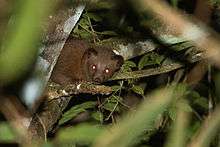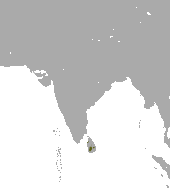Golden palm civet
The golden palm civet (Paradoxurus zeylonensis) is a palm civet endemic to Sri Lanka. It is listed as Vulnerable on the IUCN Red List. Its distribution is severely fragmented, and the extent and quality of its habitat in Sri Lanka's hill regions are declining.[1]
| Golden palm civet | |
|---|---|
 | |
| Scientific classification | |
| Kingdom: | Animalia |
| Phylum: | Chordata |
| Class: | Mammalia |
| Order: | Carnivora |
| Suborder: | Feliformia |
| Family: | Viverridae |
| Genus: | Paradoxurus |
| Species: | P. zeylonensis[2] |
| Binomial name | |
| Paradoxurus zeylonensis[2] | |
 | |
| Golden palm civet range | |
The golden palm civet was described by Peter Simon Pallas in 1778.[3]
Taxonomy
Viverra zeylonensis was the scientific name proposed by Pallas in 1778 for a palm civet specimen from Sri Lanka.[3] It was placed in the genus Paradoxurus by Edward Frederick Kelaart in 1852, who also described a fulvous brown palm civet from the mountains of Sri Lanka. He considered this specimen a variety of the golden palm civet and proposed the scientific name Paradoxurus montanus.[4]
Since zoological specimens exhibit polymorphism, it was suggested to split the golden palm civet into distinct species in 2009:[5]
- the Sri Lankan brown palm civet P. montanus,
- the golden wet-zone palm civet Paradoxurus aureus and
- the golden dry-zone palm civet Paradoxurus stenocephalus.
Genetic analysis indicates that specimens of P. montanus, P. aureus and P. stenocephalus share the same haplotype. Because of their low genetic difference, they should neither be considered distinct species nor subspecies, but junior synonyms of the golden palm civet.[6]
Characteristics
The golden palm civet is brown on the upper side, but individually variable from dark sepia to ochreous, rusty or golden-brown. The tips of the contour hairs are frequently lustrous, sometimes greyish. The legs are about the same tint as the back, but the tail and the face are sometimes noticeably paler, buffy-grey. The face does not have a pattern, and the vibrissae are dirty white. The hair in front of the shoulders radiates from two whorls and grows forward along the sides of the neck and the nape to the head. It also grows forward on the fore throat, radiating from a single whorl. The dorsal pattern consists of faint bands and spots that are slightly darker than the ground colour. The lower side is slightly paler and sometimes greyer than the upper.[7] The golden palm civet has two morphs — one golden and one dark brown.[5]
Distribution and habitat
The golden palm civet is found in lowland rain forest, evergreen mountain forests, and also dense monsoon forest.[8]
Ecology and behaviour
The golden palm civet is forest-dependent, yet tolerant of minor habitat modification where some continuous forest remains. It is arboreal, nocturnal, and solitary; its diet consists of fruits, berries, invertebrates, and a wide range of small vertebrates.[1]
In culture
In Sri Lanka the golden palm civet is called pani uguduwa පැනි උගුඩුවා, sapumal kalawaddha සපුමල් කලවැද්දා, or ranhothambuwa රන් හොතබුවා / hotambuwa හොතබුවා, by the Sinhala speaking community. Both golden and Asian palm civet are sometimes collectively called kalawedda in Sinhala and maranai (மரநாய்) in Tamil.[5]
However, the word hotambuwa is mostly used to refer altogether a different species ruddy mongoose (Herpestes smithii). Due to similar appearance and coloration, they are mistaken as the same animal.
This civet appears in 3 rupee Sri Lankan postal stamp. However, it is labeled "Golden Palm Cat" in the stamp.
References
- Duckworth, J. W.; Mudappa, D.; Pethiyagoda, R.; Woolgar, J.; de Silva Wijeyeratne, G. & Hall, J. (2016). "Paradoxurus zeylonensis". IUCN Red List of Threatened Species. 2016: e.T41694A45218119.
- Wozencraft, W.C. (2005). "Species Paradoxurus zeylonensis". In Wilson, D.E.; Reeder, D.M (eds.). Mammal Species of the World: A Taxonomic and Geographic Reference (3rd ed.). Johns Hopkins University Press. p. 551. ISBN 978-0-8018-8221-0. OCLC 62265494.
- Pallas, P. S. (1778). "Der Boshond". In Schreber, J. C. D. (ed.). Die Säugethiere in Abbildungen nach der Natur, mit Beschreibungen. Erlangen: Wolfgang Walther. p. 451.
- Kelaart, E.F. (1852). "Paradoxurus zeylanica". Prodromus faunae zeylanicae : being contributions to the zoology of Ceylon. Ceylon: Kelaart, E.F. pp. 39–41.
- Groves, C. P.; Rajapaksha, C.; Manemandra-Arachchi, K. (2009). "The taxonomy of the endemic golden palm civet of Sri Lanka" (PDF). Zoological Journal of the Linnean Society. 155: 238–251. doi:10.1111/j.1096-3642.2008.00451.x.
- Veron, G.; Patou, M.-L.; Tóth, M.; Goonatilake, M.; Jennings, A. P. (2015). "How many species of Paradoxurus civets are there? New insights from India and Sri Lanka" (PDF). Journal of Zoological Systematics and Evolutionary Research. 53 (2): 161–174. doi:10.1111/jzs.12085.
- Pocock, R. I. (1939). "Paradoxurus zeylonensis". The Fauna of British India, including Ceylon and Burma. Volume 1. Mammalia. London: Taylor and Francis. pp. 381–383.
- Schreiber, A., Wirth, R., Riffel, M. and Van Rompaey, H. (1989). Weasels, civets, mongooses, and their relatives. An Action Plan for the conservation of mustelids and viverrids. IUCN, Gland, Switzerland.
| Wikispecies has information related to Paradoxurus zeylonensis |
